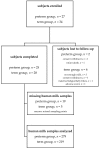Temporal Progression of Fatty Acids in Preterm and Term Human Milk of Mothers from Switzerland
- PMID: 30626044
- PMCID: PMC6356418
- DOI: 10.3390/nu11010112
Temporal Progression of Fatty Acids in Preterm and Term Human Milk of Mothers from Switzerland
Abstract
We longitudinally compared fatty acids (FA) from human milk (HM) of mothers delivering term and preterm infants. HM was collected for 4 months postpartum at 12 time points for preterm and for 2 months postpartum at 8 time points for term group. Samples were collected from the first feed of the morning, and single breast was fully expressed. FA were analyzed by gas chromatography coupled with flame ionization detector. Oleic, palmitic and linoleic acids were the most abundant FA across lactation and in both groups. Preterm colostrum contained significantly (p < 0.05) higher 8:0, 10:0, 12:0, sum medium chain fatty acids (MCFA), 18:3 n-3 FA compared to term counterparts. Preterm mature milk contained significantly higher 12:0, 14:0, 18:2 n-6, sum saturated fatty acids (SFA), and sum MCFA. We did not observe any significant differences between the preterm and term groups for docosahexaenoic acid, arachidonic acid and eicosapentaenoic acid at any stage of lactation. Overall, preterm milk was higher for SFA with a major contribution from MCFA and higher in 18:2 n-6. These observational differences needs to be studied further for their implications on preterm developmental outcomes and on fortification strategies of either mothers' own milk or donor human milk.
Keywords: arachidonic acid (ARA); docosahexaenoic acid (DHA); donor human milk; eicosapentaenoic acid (EPA); fatty acids; human milk; human milk fortification; infants; lipids; mothers’ own milk; preterm; term.
Conflict of interest statement
S.K.T., M.A., C.A.D.C., and F.G. are all employees of Nestec Ltd. L.B., J.-F.T., and C.J.F.F. declare no conflict of interest.
Figures





Similar articles
-
Temporal evolution of fatty acid content in human milk of lactating mothers from the Philippines.Prostaglandins Leukot Essent Fatty Acids. 2023 Mar;190:102543. doi: 10.1016/j.plefa.2023.102543. Epub 2023 Jan 25. Prostaglandins Leukot Essent Fatty Acids. 2023. PMID: 36724727
-
Differences in preterm and term milk fatty acid compositions may be caused by the different hormonal milieu of early parturition.Prostaglandins Leukot Essent Fatty Acids. 2011 Dec;85(6):369-79. doi: 10.1016/j.plefa.2011.08.001. Epub 2011 Sep 7. Prostaglandins Leukot Essent Fatty Acids. 2011. PMID: 21903369
-
Human milk fatty acid profile across lactational stages after term and preterm delivery: A pooled data analysis.Prostaglandins Leukot Essent Fatty Acids. 2020 May;156:102023. doi: 10.1016/j.plefa.2019.102023. Epub 2019 Oct 16. Prostaglandins Leukot Essent Fatty Acids. 2020. PMID: 31699594 Review.
-
[Fatty acid composition of human milk in mothers of preterm and full-term infants in the first three weeks of lactation].Orv Hetil. 2006 Aug 6;147(31):1459-63. Orv Hetil. 2006. PMID: 16981419 Hungarian.
-
Long-Chain Polyunsaturated Fatty Acids (LCPUFAs) and the Developing Immune System: A Narrative Review.Nutrients. 2021 Jan 16;13(1):247. doi: 10.3390/nu13010247. Nutrients. 2021. PMID: 33467123 Free PMC article. Review.
Cited by
-
Novel approach to visualize the inter-dependencies between maternal sensitization, breast milk immune components and human milk oligosaccharides in the LIFE Child cohort.PLoS One. 2020 Apr 21;15(4):e0230472. doi: 10.1371/journal.pone.0230472. eCollection 2020. PLoS One. 2020. PMID: 32315306 Free PMC article.
-
Association of DHA Concentration in Human Breast Milk with Maternal Diet and Use of Supplements: A Cross-Sectional Analysis of Data from the Japanese Human Milk Study Cohort.Curr Dev Nutr. 2020 Jun 15;4(7):nzaa105. doi: 10.1093/cdn/nzaa105. eCollection 2020 Jul. Curr Dev Nutr. 2020. PMID: 32666036 Free PMC article.
-
Preparation of Human Milk Fat Substitutes: A Review.Life (Basel). 2022 Jan 27;12(2):187. doi: 10.3390/life12020187. Life (Basel). 2022. PMID: 35207476 Free PMC article. Review.
-
Human Milk Lipids Induce Important Metabolic and Epigenetic Changes in Neonates.Clin Perinatol. 2022 Jun;49(2):331-353. doi: 10.1016/j.clp.2022.02.006. Clin Perinatol. 2022. PMID: 35659090 Free PMC article. Review.
-
Quantification of Nervonic Acid in Human Milk in the First 30 Days of Lactation: Influence of Lactation Stages and Comparison with Infant Formulae.Nutrients. 2019 Aug 14;11(8):1892. doi: 10.3390/nu11081892. Nutrients. 2019. PMID: 31416149 Free PMC article.
References
Publication types
MeSH terms
Substances
Grants and funding
LinkOut - more resources
Full Text Sources
Research Materials

